Exploring Issues of the French-Speaking Population in Canada
VerifiedAdded on 2023/06/10
|9
|2438
|161
Essay
AI Summary
This essay examines the challenges faced by the French-speaking population in Canada, drawing upon three articles that highlight key issues. It discusses the increasing linguistic diversity and bilingualism among French speakers, the decline of native French speakers in Quebec due to the prominence of English, and Quebec's language policies aimed at protecting the French language. The analysis includes statistical data illustrating bilingualism rates across different regions and age groups, emphasizing the difficulties encountered by French speakers in various settings such as workplaces and schools. The essay concludes by noting the Quebecois ruling party's efforts to promote the use of French and address these challenges, while also acknowledging the need for improved communication between French and English speakers for better integration and understanding. Desklib provides access to similar essays and study resources for students.
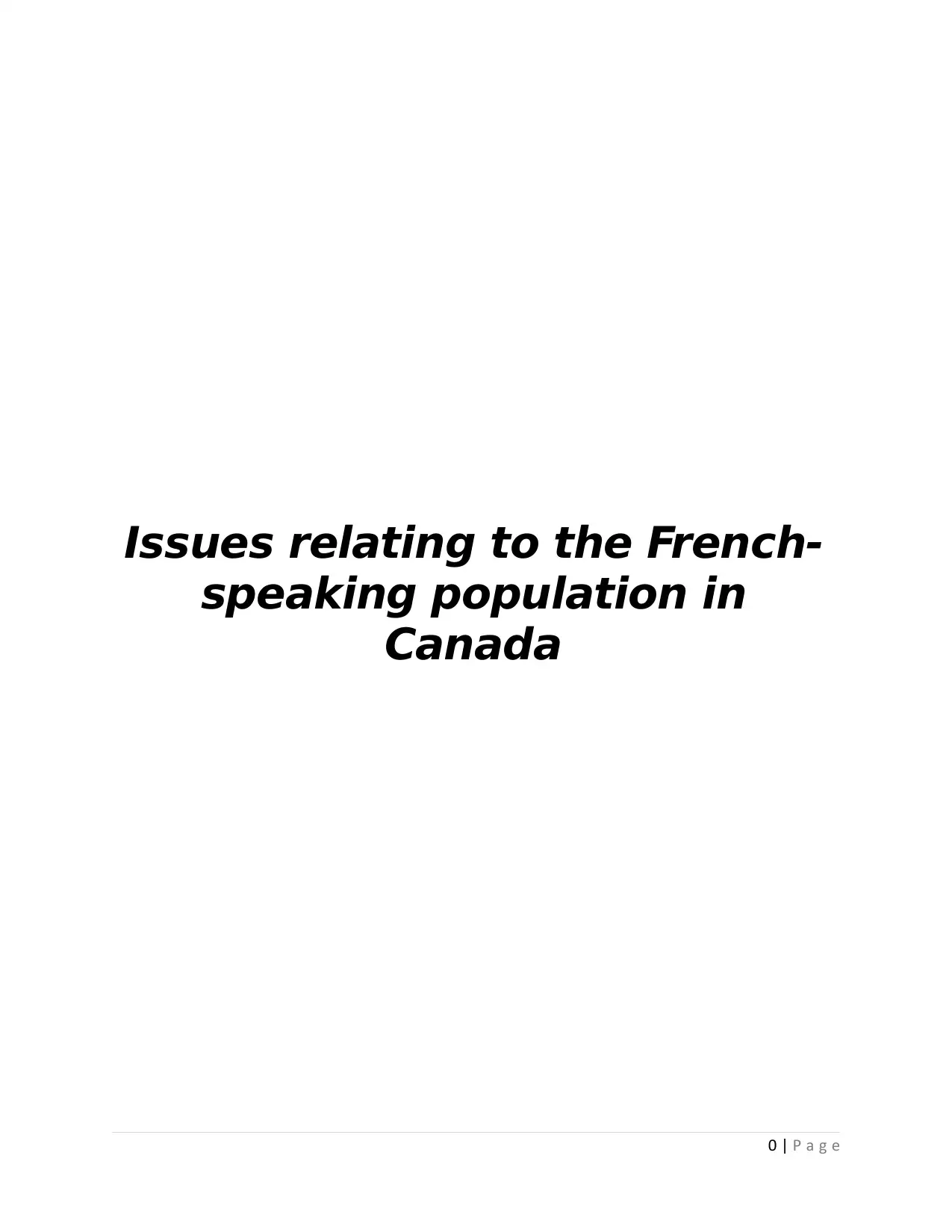
Issues relating to the French-
speaking population in
Canada
0 | P a g e
speaking population in
Canada
0 | P a g e
Paraphrase This Document
Need a fresh take? Get an instant paraphrase of this document with our AI Paraphraser
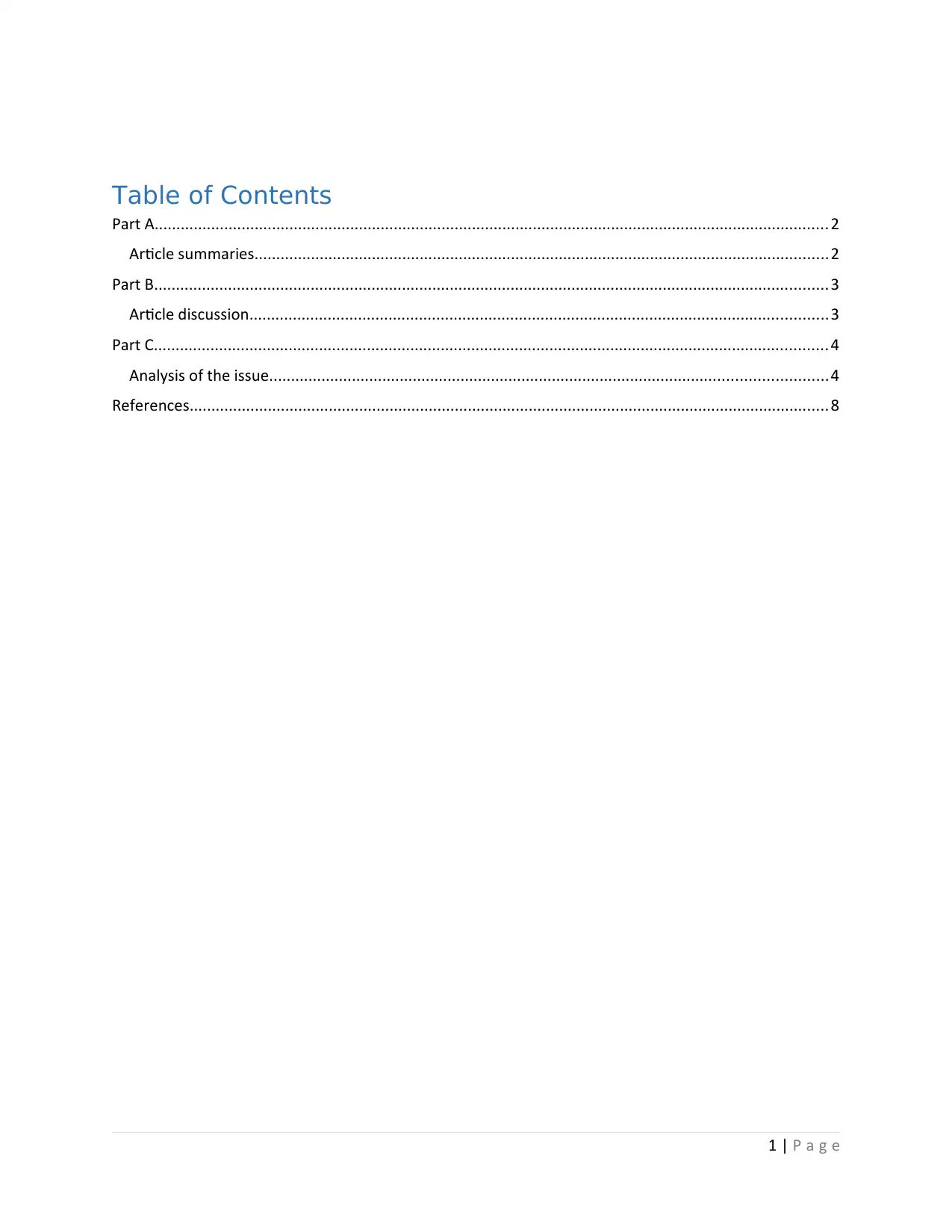
Table of Contents
Part A...........................................................................................................................................................2
Article summaries....................................................................................................................................2
Part B...........................................................................................................................................................3
Article discussion.....................................................................................................................................3
Part C...........................................................................................................................................................4
Analysis of the issue................................................................................................................................4
References...................................................................................................................................................8
1 | P a g e
Part A...........................................................................................................................................................2
Article summaries....................................................................................................................................2
Part B...........................................................................................................................................................3
Article discussion.....................................................................................................................................3
Part C...........................................................................................................................................................4
Analysis of the issue................................................................................................................................4
References...................................................................................................................................................8
1 | P a g e
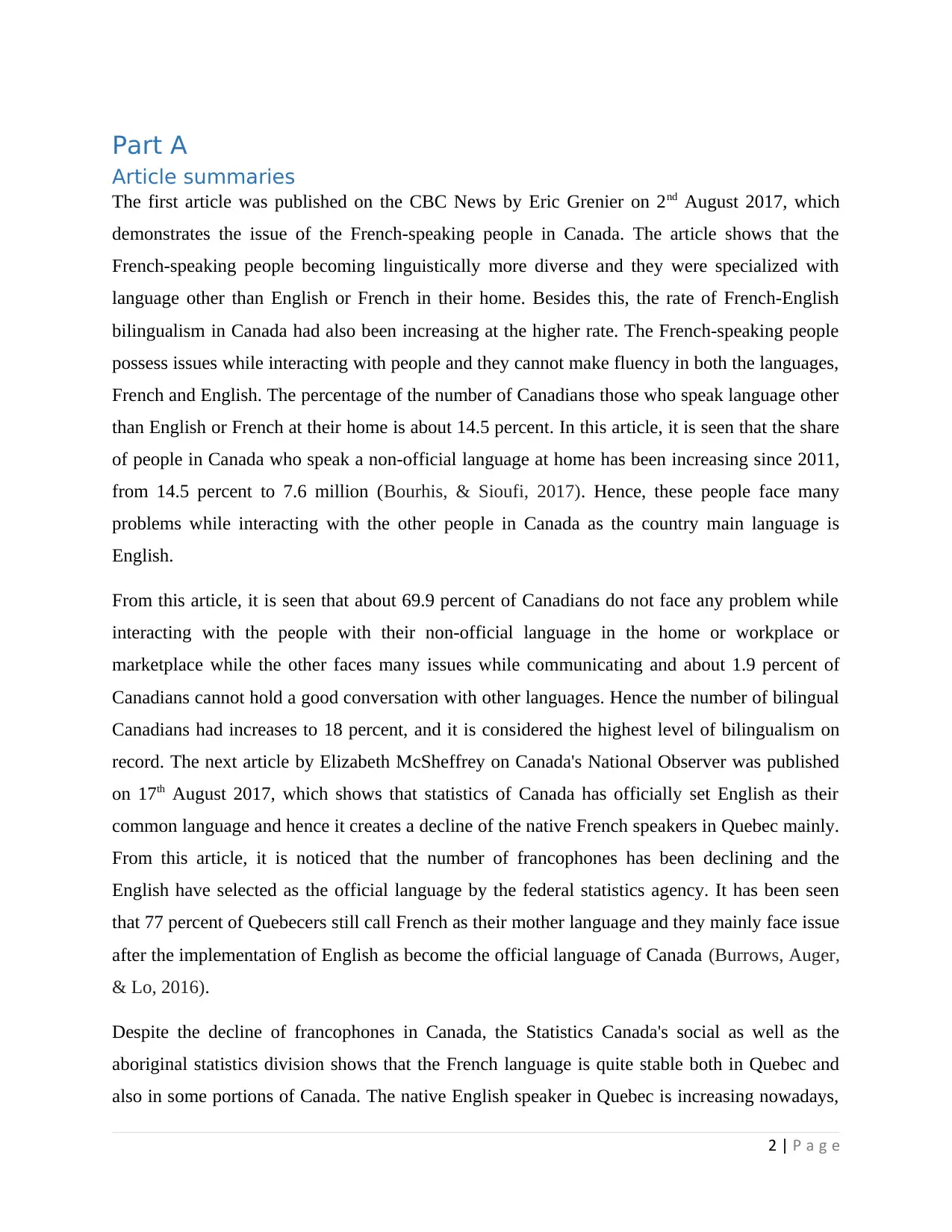
Part A
Article summaries
The first article was published on the CBC News by Eric Grenier on 2nd August 2017, which
demonstrates the issue of the French-speaking people in Canada. The article shows that the
French-speaking people becoming linguistically more diverse and they were specialized with
language other than English or French in their home. Besides this, the rate of French-English
bilingualism in Canada had also been increasing at the higher rate. The French-speaking people
possess issues while interacting with people and they cannot make fluency in both the languages,
French and English. The percentage of the number of Canadians those who speak language other
than English or French at their home is about 14.5 percent. In this article, it is seen that the share
of people in Canada who speak a non-official language at home has been increasing since 2011,
from 14.5 percent to 7.6 million (Bourhis, & Sioufi, 2017). Hence, these people face many
problems while interacting with the other people in Canada as the country main language is
English.
From this article, it is seen that about 69.9 percent of Canadians do not face any problem while
interacting with the people with their non-official language in the home or workplace or
marketplace while the other faces many issues while communicating and about 1.9 percent of
Canadians cannot hold a good conversation with other languages. Hence the number of bilingual
Canadians had increases to 18 percent, and it is considered the highest level of bilingualism on
record. The next article by Elizabeth McSheffrey on Canada's National Observer was published
on 17th August 2017, which shows that statistics of Canada has officially set English as their
common language and hence it creates a decline of the native French speakers in Quebec mainly.
From this article, it is noticed that the number of francophones has been declining and the
English have selected as the official language by the federal statistics agency. It has been seen
that 77 percent of Quebecers still call French as their mother language and they mainly face issue
after the implementation of English as become the official language of Canada (Burrows, Auger,
& Lo, 2016).
Despite the decline of francophones in Canada, the Statistics Canada's social as well as the
aboriginal statistics division shows that the French language is quite stable both in Quebec and
also in some portions of Canada. The native English speaker in Quebec is increasing nowadays,
2 | P a g e
Article summaries
The first article was published on the CBC News by Eric Grenier on 2nd August 2017, which
demonstrates the issue of the French-speaking people in Canada. The article shows that the
French-speaking people becoming linguistically more diverse and they were specialized with
language other than English or French in their home. Besides this, the rate of French-English
bilingualism in Canada had also been increasing at the higher rate. The French-speaking people
possess issues while interacting with people and they cannot make fluency in both the languages,
French and English. The percentage of the number of Canadians those who speak language other
than English or French at their home is about 14.5 percent. In this article, it is seen that the share
of people in Canada who speak a non-official language at home has been increasing since 2011,
from 14.5 percent to 7.6 million (Bourhis, & Sioufi, 2017). Hence, these people face many
problems while interacting with the other people in Canada as the country main language is
English.
From this article, it is seen that about 69.9 percent of Canadians do not face any problem while
interacting with the people with their non-official language in the home or workplace or
marketplace while the other faces many issues while communicating and about 1.9 percent of
Canadians cannot hold a good conversation with other languages. Hence the number of bilingual
Canadians had increases to 18 percent, and it is considered the highest level of bilingualism on
record. The next article by Elizabeth McSheffrey on Canada's National Observer was published
on 17th August 2017, which shows that statistics of Canada has officially set English as their
common language and hence it creates a decline of the native French speakers in Quebec mainly.
From this article, it is noticed that the number of francophones has been declining and the
English have selected as the official language by the federal statistics agency. It has been seen
that 77 percent of Quebecers still call French as their mother language and they mainly face issue
after the implementation of English as become the official language of Canada (Burrows, Auger,
& Lo, 2016).
Despite the decline of francophones in Canada, the Statistics Canada's social as well as the
aboriginal statistics division shows that the French language is quite stable both in Quebec and
also in some portions of Canada. The native English speaker in Quebec is increasing nowadays,
2 | P a g e
⊘ This is a preview!⊘
Do you want full access?
Subscribe today to unlock all pages.

Trusted by 1+ million students worldwide
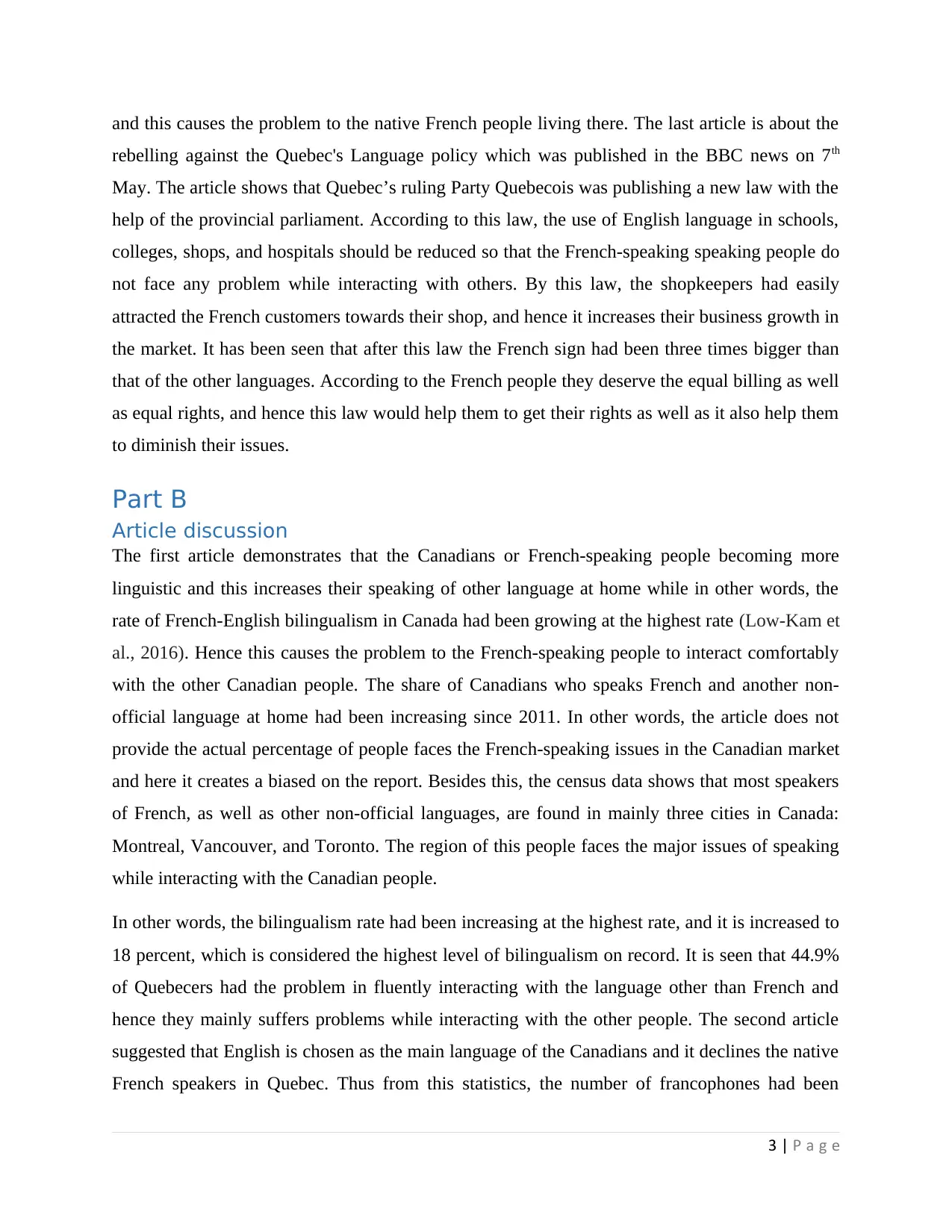
and this causes the problem to the native French people living there. The last article is about the
rebelling against the Quebec's Language policy which was published in the BBC news on 7th
May. The article shows that Quebec’s ruling Party Quebecois was publishing a new law with the
help of the provincial parliament. According to this law, the use of English language in schools,
colleges, shops, and hospitals should be reduced so that the French-speaking speaking people do
not face any problem while interacting with others. By this law, the shopkeepers had easily
attracted the French customers towards their shop, and hence it increases their business growth in
the market. It has been seen that after this law the French sign had been three times bigger than
that of the other languages. According to the French people they deserve the equal billing as well
as equal rights, and hence this law would help them to get their rights as well as it also help them
to diminish their issues.
Part B
Article discussion
The first article demonstrates that the Canadians or French-speaking people becoming more
linguistic and this increases their speaking of other language at home while in other words, the
rate of French-English bilingualism in Canada had been growing at the highest rate (Low-Kam et
al., 2016). Hence this causes the problem to the French-speaking people to interact comfortably
with the other Canadian people. The share of Canadians who speaks French and another non-
official language at home had been increasing since 2011. In other words, the article does not
provide the actual percentage of people faces the French-speaking issues in the Canadian market
and here it creates a biased on the report. Besides this, the census data shows that most speakers
of French, as well as other non-official languages, are found in mainly three cities in Canada:
Montreal, Vancouver, and Toronto. The region of this people faces the major issues of speaking
while interacting with the Canadian people.
In other words, the bilingualism rate had been increasing at the highest rate, and it is increased to
18 percent, which is considered the highest level of bilingualism on record. It is seen that 44.9%
of Quebecers had the problem in fluently interacting with the language other than French and
hence they mainly suffers problems while interacting with the other people. The second article
suggested that English is chosen as the main language of the Canadians and it declines the native
French speakers in Quebec. Thus from this statistics, the number of francophones had been
3 | P a g e
rebelling against the Quebec's Language policy which was published in the BBC news on 7th
May. The article shows that Quebec’s ruling Party Quebecois was publishing a new law with the
help of the provincial parliament. According to this law, the use of English language in schools,
colleges, shops, and hospitals should be reduced so that the French-speaking speaking people do
not face any problem while interacting with others. By this law, the shopkeepers had easily
attracted the French customers towards their shop, and hence it increases their business growth in
the market. It has been seen that after this law the French sign had been three times bigger than
that of the other languages. According to the French people they deserve the equal billing as well
as equal rights, and hence this law would help them to get their rights as well as it also help them
to diminish their issues.
Part B
Article discussion
The first article demonstrates that the Canadians or French-speaking people becoming more
linguistic and this increases their speaking of other language at home while in other words, the
rate of French-English bilingualism in Canada had been growing at the highest rate (Low-Kam et
al., 2016). Hence this causes the problem to the French-speaking people to interact comfortably
with the other Canadian people. The share of Canadians who speaks French and another non-
official language at home had been increasing since 2011. In other words, the article does not
provide the actual percentage of people faces the French-speaking issues in the Canadian market
and here it creates a biased on the report. Besides this, the census data shows that most speakers
of French, as well as other non-official languages, are found in mainly three cities in Canada:
Montreal, Vancouver, and Toronto. The region of this people faces the major issues of speaking
while interacting with the Canadian people.
In other words, the bilingualism rate had been increasing at the highest rate, and it is increased to
18 percent, which is considered the highest level of bilingualism on record. It is seen that 44.9%
of Quebecers had the problem in fluently interacting with the language other than French and
hence they mainly suffers problems while interacting with the other people. The second article
suggested that English is chosen as the main language of the Canadians and it declines the native
French speakers in Quebec. Thus from this statistics, the number of francophones had been
3 | P a g e
Paraphrase This Document
Need a fresh take? Get an instant paraphrase of this document with our AI Paraphraser
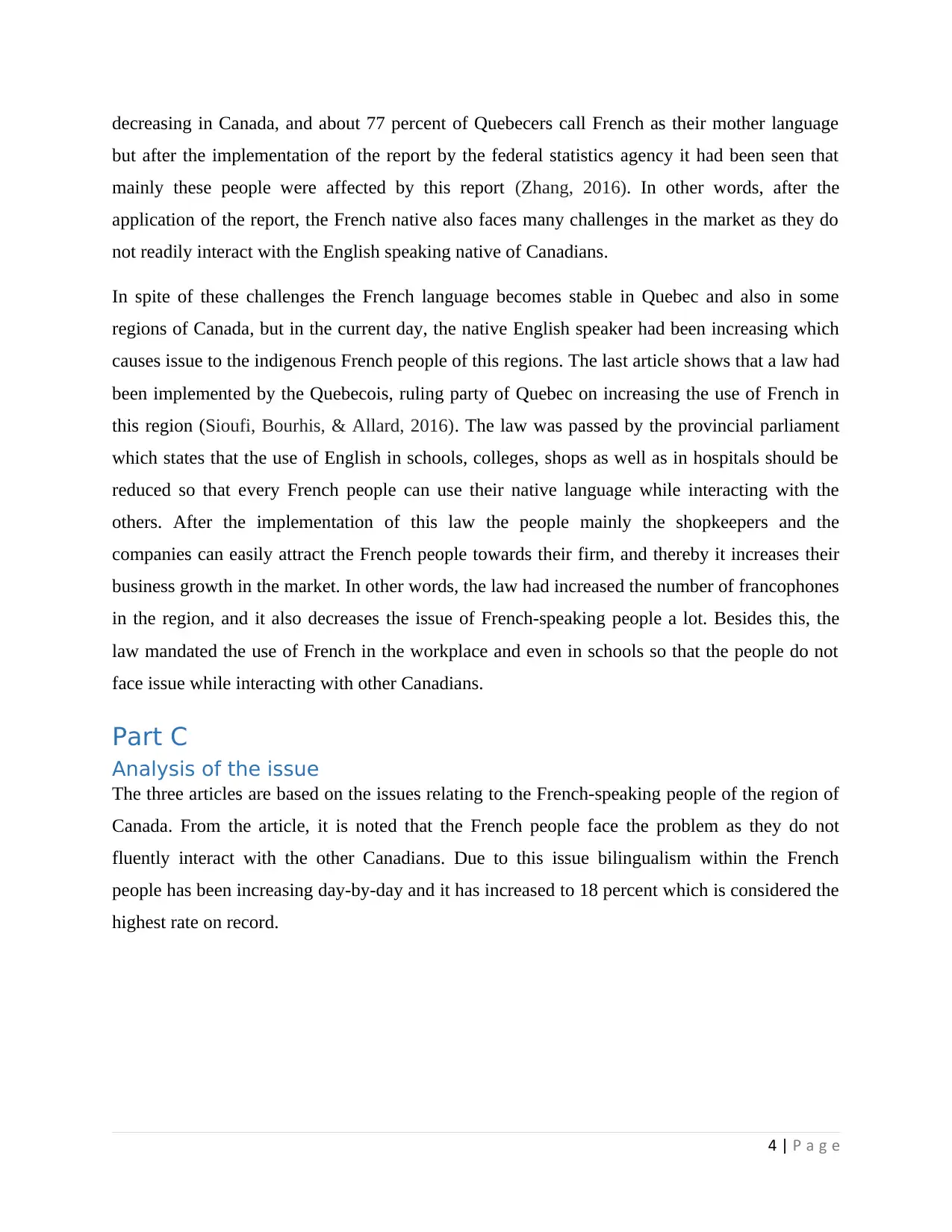
decreasing in Canada, and about 77 percent of Quebecers call French as their mother language
but after the implementation of the report by the federal statistics agency it had been seen that
mainly these people were affected by this report (Zhang, 2016). In other words, after the
application of the report, the French native also faces many challenges in the market as they do
not readily interact with the English speaking native of Canadians.
In spite of these challenges the French language becomes stable in Quebec and also in some
regions of Canada, but in the current day, the native English speaker had been increasing which
causes issue to the indigenous French people of this regions. The last article shows that a law had
been implemented by the Quebecois, ruling party of Quebec on increasing the use of French in
this region (Sioufi, Bourhis, & Allard, 2016). The law was passed by the provincial parliament
which states that the use of English in schools, colleges, shops as well as in hospitals should be
reduced so that every French people can use their native language while interacting with the
others. After the implementation of this law the people mainly the shopkeepers and the
companies can easily attract the French people towards their firm, and thereby it increases their
business growth in the market. In other words, the law had increased the number of francophones
in the region, and it also decreases the issue of French-speaking people a lot. Besides this, the
law mandated the use of French in the workplace and even in schools so that the people do not
face issue while interacting with other Canadians.
Part C
Analysis of the issue
The three articles are based on the issues relating to the French-speaking people of the region of
Canada. From the article, it is noted that the French people face the problem as they do not
fluently interact with the other Canadians. Due to this issue bilingualism within the French
people has been increasing day-by-day and it has increased to 18 percent which is considered the
highest rate on record.
4 | P a g e
but after the implementation of the report by the federal statistics agency it had been seen that
mainly these people were affected by this report (Zhang, 2016). In other words, after the
application of the report, the French native also faces many challenges in the market as they do
not readily interact with the English speaking native of Canadians.
In spite of these challenges the French language becomes stable in Quebec and also in some
regions of Canada, but in the current day, the native English speaker had been increasing which
causes issue to the indigenous French people of this regions. The last article shows that a law had
been implemented by the Quebecois, ruling party of Quebec on increasing the use of French in
this region (Sioufi, Bourhis, & Allard, 2016). The law was passed by the provincial parliament
which states that the use of English in schools, colleges, shops as well as in hospitals should be
reduced so that every French people can use their native language while interacting with the
others. After the implementation of this law the people mainly the shopkeepers and the
companies can easily attract the French people towards their firm, and thereby it increases their
business growth in the market. In other words, the law had increased the number of francophones
in the region, and it also decreases the issue of French-speaking people a lot. Besides this, the
law mandated the use of French in the workplace and even in schools so that the people do not
face issue while interacting with other Canadians.
Part C
Analysis of the issue
The three articles are based on the issues relating to the French-speaking people of the region of
Canada. From the article, it is noted that the French people face the problem as they do not
fluently interact with the other Canadians. Due to this issue bilingualism within the French
people has been increasing day-by-day and it has increased to 18 percent which is considered the
highest rate on record.
4 | P a g e
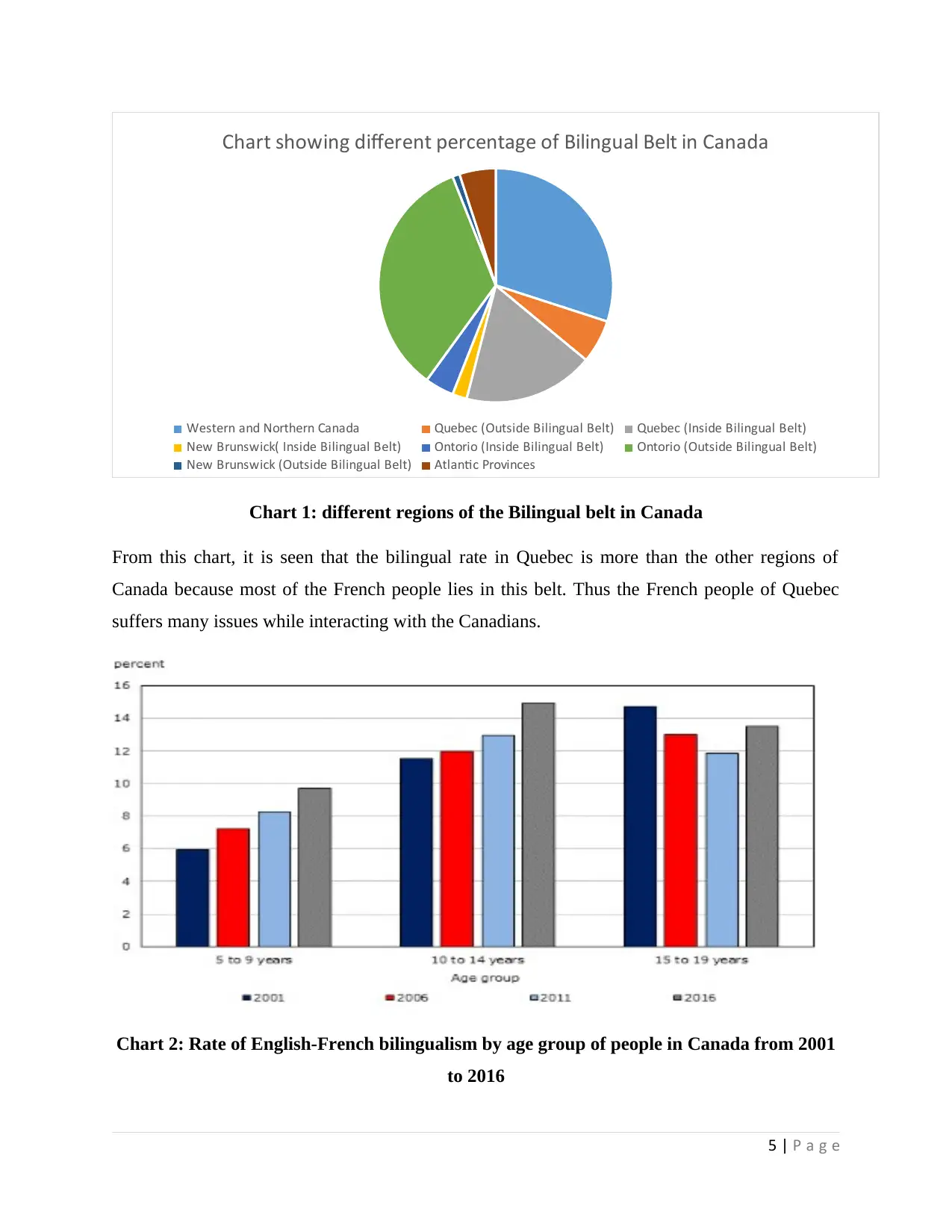
Chart showing different percentage of Bilingual Belt in Canada
Western and Northern Canada Quebec (Outside Bilingual Belt) Quebec (Inside Bilingual Belt)
New Brunswick( Inside Bilingual Belt) Ontorio (Inside Bilingual Belt) Ontorio (Outside Bilingual Belt)
New Brunswick (Outside Bilingual Belt) Atlantic Provinces
Chart 1: different regions of the Bilingual belt in Canada
From this chart, it is seen that the bilingual rate in Quebec is more than the other regions of
Canada because most of the French people lies in this belt. Thus the French people of Quebec
suffers many issues while interacting with the Canadians.
Chart 2: Rate of English-French bilingualism by age group of people in Canada from 2001
to 2016
5 | P a g e
Western and Northern Canada Quebec (Outside Bilingual Belt) Quebec (Inside Bilingual Belt)
New Brunswick( Inside Bilingual Belt) Ontorio (Inside Bilingual Belt) Ontorio (Outside Bilingual Belt)
New Brunswick (Outside Bilingual Belt) Atlantic Provinces
Chart 1: different regions of the Bilingual belt in Canada
From this chart, it is seen that the bilingual rate in Quebec is more than the other regions of
Canada because most of the French people lies in this belt. Thus the French people of Quebec
suffers many issues while interacting with the Canadians.
Chart 2: Rate of English-French bilingualism by age group of people in Canada from 2001
to 2016
5 | P a g e
⊘ This is a preview!⊘
Do you want full access?
Subscribe today to unlock all pages.

Trusted by 1+ million students worldwide
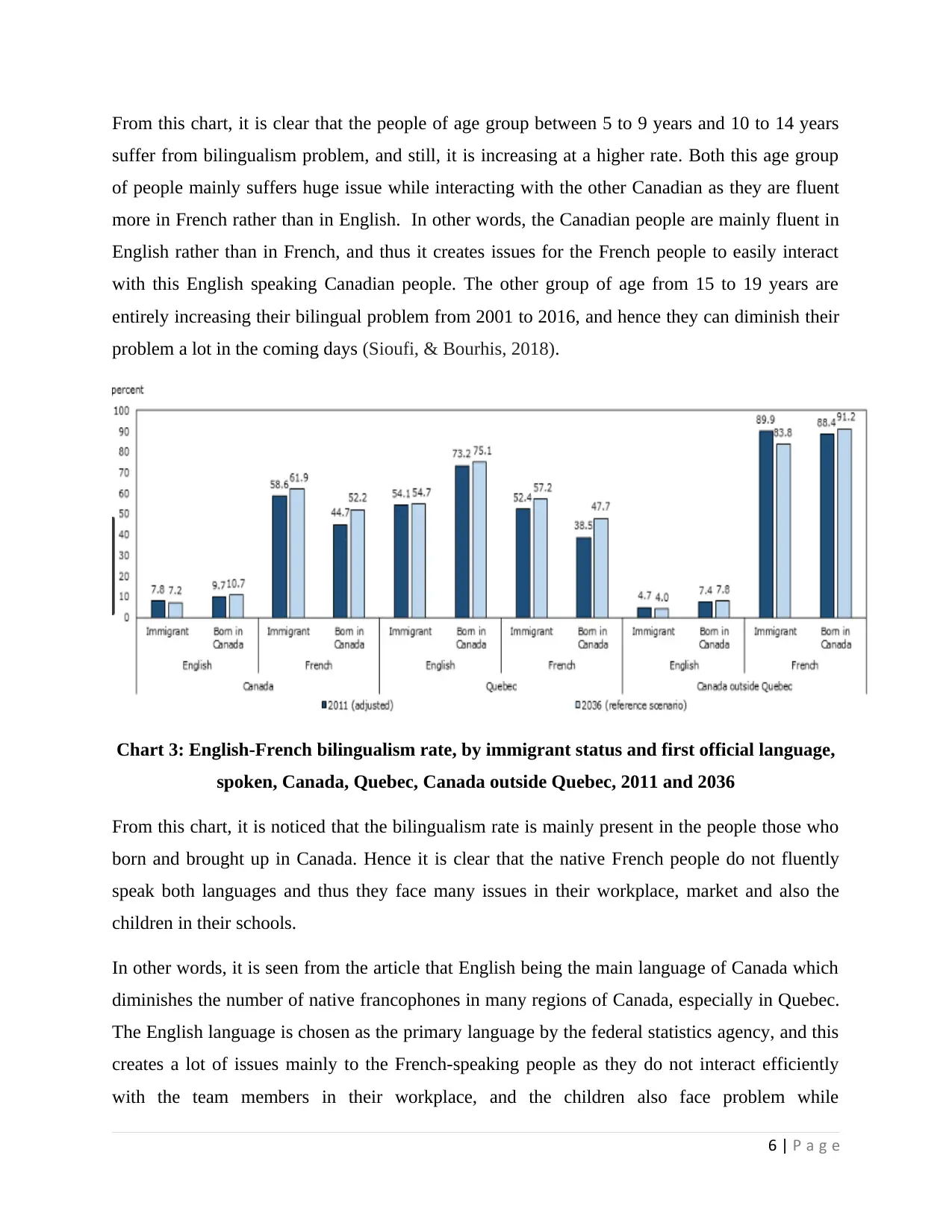
From this chart, it is clear that the people of age group between 5 to 9 years and 10 to 14 years
suffer from bilingualism problem, and still, it is increasing at a higher rate. Both this age group
of people mainly suffers huge issue while interacting with the other Canadian as they are fluent
more in French rather than in English. In other words, the Canadian people are mainly fluent in
English rather than in French, and thus it creates issues for the French people to easily interact
with this English speaking Canadian people. The other group of age from 15 to 19 years are
entirely increasing their bilingual problem from 2001 to 2016, and hence they can diminish their
problem a lot in the coming days (Sioufi, & Bourhis, 2018).
Chart 3: English-French bilingualism rate, by immigrant status and first official language,
spoken, Canada, Quebec, Canada outside Quebec, 2011 and 2036
From this chart, it is noticed that the bilingualism rate is mainly present in the people those who
born and brought up in Canada. Hence it is clear that the native French people do not fluently
speak both languages and thus they face many issues in their workplace, market and also the
children in their schools.
In other words, it is seen from the article that English being the main language of Canada which
diminishes the number of native francophones in many regions of Canada, especially in Quebec.
The English language is chosen as the primary language by the federal statistics agency, and this
creates a lot of issues mainly to the French-speaking people as they do not interact efficiently
with the team members in their workplace, and the children also face problem while
6 | P a g e
suffer from bilingualism problem, and still, it is increasing at a higher rate. Both this age group
of people mainly suffers huge issue while interacting with the other Canadian as they are fluent
more in French rather than in English. In other words, the Canadian people are mainly fluent in
English rather than in French, and thus it creates issues for the French people to easily interact
with this English speaking Canadian people. The other group of age from 15 to 19 years are
entirely increasing their bilingual problem from 2001 to 2016, and hence they can diminish their
problem a lot in the coming days (Sioufi, & Bourhis, 2018).
Chart 3: English-French bilingualism rate, by immigrant status and first official language,
spoken, Canada, Quebec, Canada outside Quebec, 2011 and 2036
From this chart, it is noticed that the bilingualism rate is mainly present in the people those who
born and brought up in Canada. Hence it is clear that the native French people do not fluently
speak both languages and thus they face many issues in their workplace, market and also the
children in their schools.
In other words, it is seen from the article that English being the main language of Canada which
diminishes the number of native francophones in many regions of Canada, especially in Quebec.
The English language is chosen as the primary language by the federal statistics agency, and this
creates a lot of issues mainly to the French-speaking people as they do not interact efficiently
with the team members in their workplace, and the children also face problem while
6 | P a g e
Paraphrase This Document
Need a fresh take? Get an instant paraphrase of this document with our AI Paraphraser
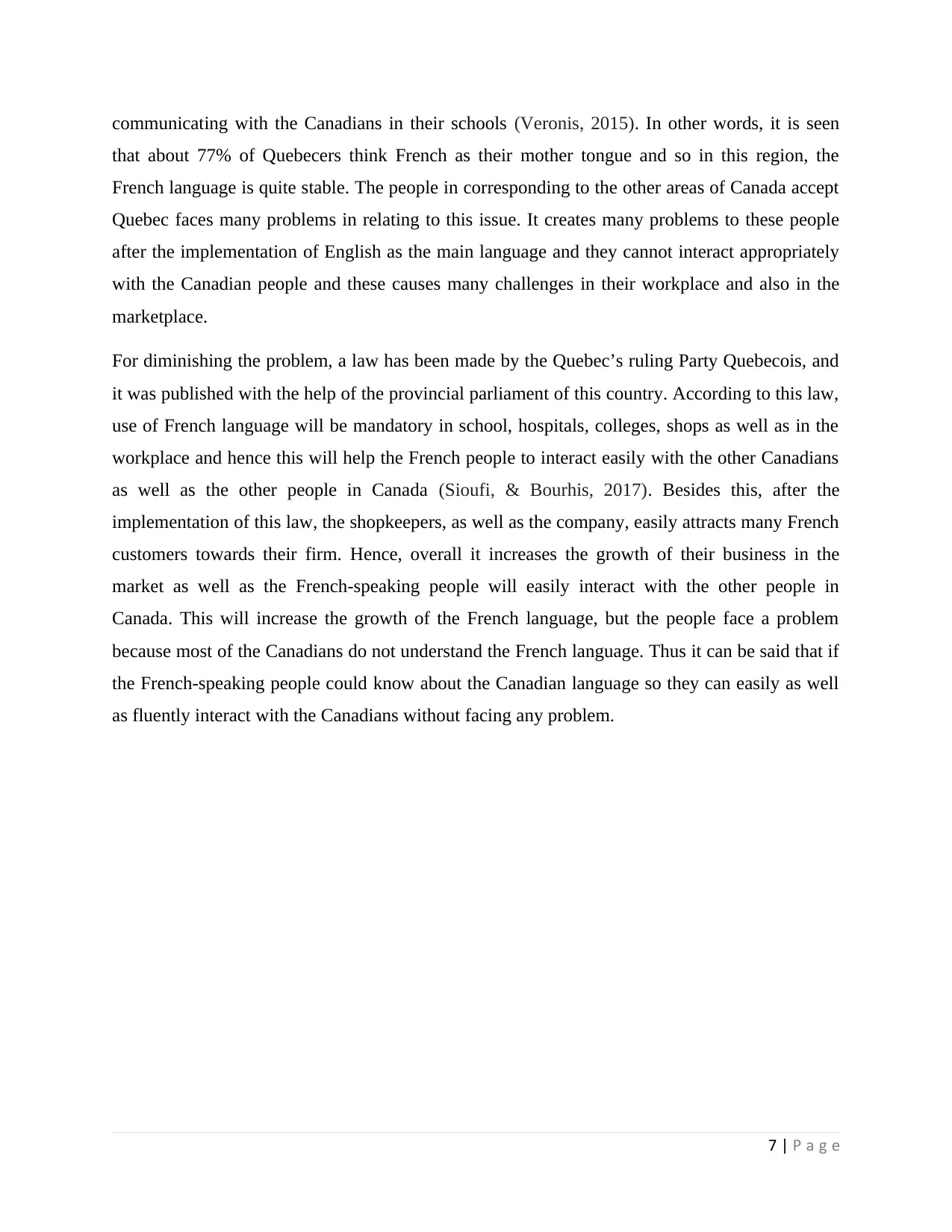
communicating with the Canadians in their schools (Veronis, 2015). In other words, it is seen
that about 77% of Quebecers think French as their mother tongue and so in this region, the
French language is quite stable. The people in corresponding to the other areas of Canada accept
Quebec faces many problems in relating to this issue. It creates many problems to these people
after the implementation of English as the main language and they cannot interact appropriately
with the Canadian people and these causes many challenges in their workplace and also in the
marketplace.
For diminishing the problem, a law has been made by the Quebec’s ruling Party Quebecois, and
it was published with the help of the provincial parliament of this country. According to this law,
use of French language will be mandatory in school, hospitals, colleges, shops as well as in the
workplace and hence this will help the French people to interact easily with the other Canadians
as well as the other people in Canada (Sioufi, & Bourhis, 2017). Besides this, after the
implementation of this law, the shopkeepers, as well as the company, easily attracts many French
customers towards their firm. Hence, overall it increases the growth of their business in the
market as well as the French-speaking people will easily interact with the other people in
Canada. This will increase the growth of the French language, but the people face a problem
because most of the Canadians do not understand the French language. Thus it can be said that if
the French-speaking people could know about the Canadian language so they can easily as well
as fluently interact with the Canadians without facing any problem.
7 | P a g e
that about 77% of Quebecers think French as their mother tongue and so in this region, the
French language is quite stable. The people in corresponding to the other areas of Canada accept
Quebec faces many problems in relating to this issue. It creates many problems to these people
after the implementation of English as the main language and they cannot interact appropriately
with the Canadian people and these causes many challenges in their workplace and also in the
marketplace.
For diminishing the problem, a law has been made by the Quebec’s ruling Party Quebecois, and
it was published with the help of the provincial parliament of this country. According to this law,
use of French language will be mandatory in school, hospitals, colleges, shops as well as in the
workplace and hence this will help the French people to interact easily with the other Canadians
as well as the other people in Canada (Sioufi, & Bourhis, 2017). Besides this, after the
implementation of this law, the shopkeepers, as well as the company, easily attracts many French
customers towards their firm. Hence, overall it increases the growth of their business in the
market as well as the French-speaking people will easily interact with the other people in
Canada. This will increase the growth of the French language, but the people face a problem
because most of the Canadians do not understand the French language. Thus it can be said that if
the French-speaking people could know about the Canadian language so they can easily as well
as fluently interact with the Canadians without facing any problem.
7 | P a g e
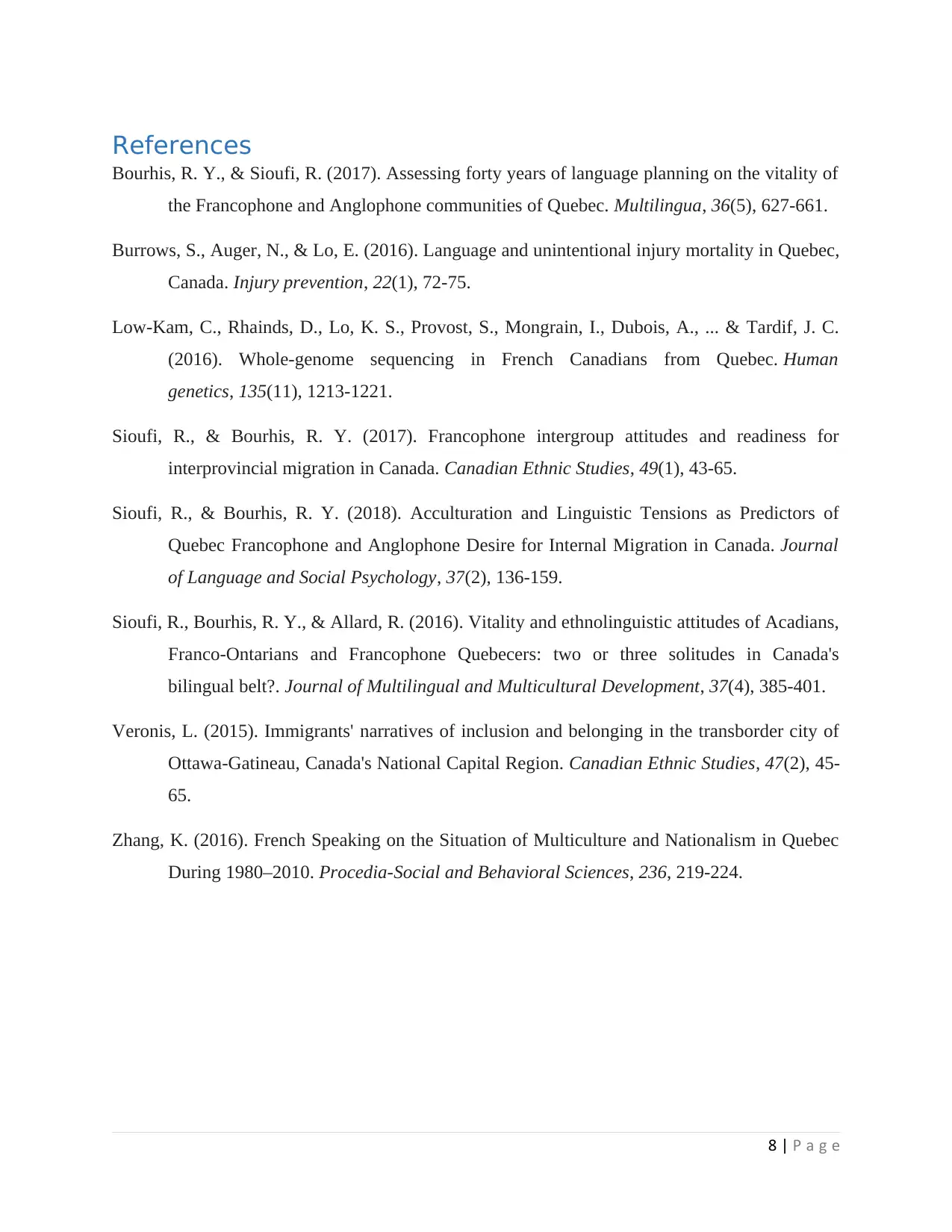
References
Bourhis, R. Y., & Sioufi, R. (2017). Assessing forty years of language planning on the vitality of
the Francophone and Anglophone communities of Quebec. Multilingua, 36(5), 627-661.
Burrows, S., Auger, N., & Lo, E. (2016). Language and unintentional injury mortality in Quebec,
Canada. Injury prevention, 22(1), 72-75.
Low-Kam, C., Rhainds, D., Lo, K. S., Provost, S., Mongrain, I., Dubois, A., ... & Tardif, J. C.
(2016). Whole-genome sequencing in French Canadians from Quebec. Human
genetics, 135(11), 1213-1221.
Sioufi, R., & Bourhis, R. Y. (2017). Francophone intergroup attitudes and readiness for
interprovincial migration in Canada. Canadian Ethnic Studies, 49(1), 43-65.
Sioufi, R., & Bourhis, R. Y. (2018). Acculturation and Linguistic Tensions as Predictors of
Quebec Francophone and Anglophone Desire for Internal Migration in Canada. Journal
of Language and Social Psychology, 37(2), 136-159.
Sioufi, R., Bourhis, R. Y., & Allard, R. (2016). Vitality and ethnolinguistic attitudes of Acadians,
Franco-Ontarians and Francophone Quebecers: two or three solitudes in Canada's
bilingual belt?. Journal of Multilingual and Multicultural Development, 37(4), 385-401.
Veronis, L. (2015). Immigrants' narratives of inclusion and belonging in the transborder city of
Ottawa-Gatineau, Canada's National Capital Region. Canadian Ethnic Studies, 47(2), 45-
65.
Zhang, K. (2016). French Speaking on the Situation of Multiculture and Nationalism in Quebec
During 1980–2010. Procedia-Social and Behavioral Sciences, 236, 219-224.
8 | P a g e
Bourhis, R. Y., & Sioufi, R. (2017). Assessing forty years of language planning on the vitality of
the Francophone and Anglophone communities of Quebec. Multilingua, 36(5), 627-661.
Burrows, S., Auger, N., & Lo, E. (2016). Language and unintentional injury mortality in Quebec,
Canada. Injury prevention, 22(1), 72-75.
Low-Kam, C., Rhainds, D., Lo, K. S., Provost, S., Mongrain, I., Dubois, A., ... & Tardif, J. C.
(2016). Whole-genome sequencing in French Canadians from Quebec. Human
genetics, 135(11), 1213-1221.
Sioufi, R., & Bourhis, R. Y. (2017). Francophone intergroup attitudes and readiness for
interprovincial migration in Canada. Canadian Ethnic Studies, 49(1), 43-65.
Sioufi, R., & Bourhis, R. Y. (2018). Acculturation and Linguistic Tensions as Predictors of
Quebec Francophone and Anglophone Desire for Internal Migration in Canada. Journal
of Language and Social Psychology, 37(2), 136-159.
Sioufi, R., Bourhis, R. Y., & Allard, R. (2016). Vitality and ethnolinguistic attitudes of Acadians,
Franco-Ontarians and Francophone Quebecers: two or three solitudes in Canada's
bilingual belt?. Journal of Multilingual and Multicultural Development, 37(4), 385-401.
Veronis, L. (2015). Immigrants' narratives of inclusion and belonging in the transborder city of
Ottawa-Gatineau, Canada's National Capital Region. Canadian Ethnic Studies, 47(2), 45-
65.
Zhang, K. (2016). French Speaking on the Situation of Multiculture and Nationalism in Quebec
During 1980–2010. Procedia-Social and Behavioral Sciences, 236, 219-224.
8 | P a g e
⊘ This is a preview!⊘
Do you want full access?
Subscribe today to unlock all pages.

Trusted by 1+ million students worldwide
1 out of 9
Related Documents
Your All-in-One AI-Powered Toolkit for Academic Success.
+13062052269
info@desklib.com
Available 24*7 on WhatsApp / Email
![[object Object]](/_next/static/media/star-bottom.7253800d.svg)
Unlock your academic potential
Copyright © 2020–2025 A2Z Services. All Rights Reserved. Developed and managed by ZUCOL.





